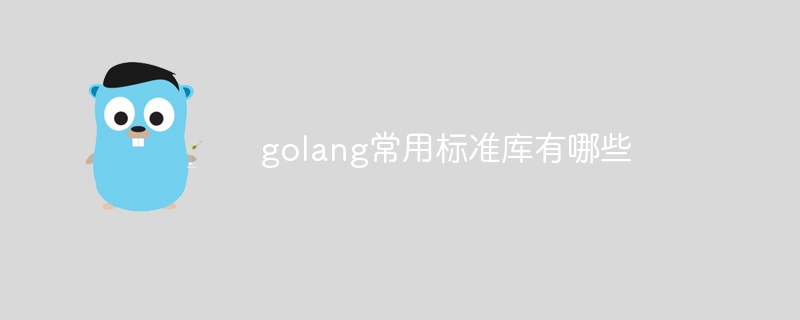Home >Backend Development >Golang >What are the commonly used standard libraries in golang?
What are the commonly used standard libraries in golang?
- zbtOriginal
- 2023-12-14 13:33:091266browse
Golang commonly used standard libraries include fmt, io, net, os, time, sync, encoding, database/sql, unicode, math, crypto, runtime, flag, reflect and testing. Detailed introduction: 1. fmt, which provides functions for formatting text input and output; 2. io, which includes some basic I/O interfaces and functions; 3. net, which includes functions and interfaces for network programming; 4 , os and so on.

The operating system for this tutorial: Windows 10 system, Go version 1.21, DELL G3 computer.
Golang is an efficient programming language for modern application development. The standard library provides a large number of functions and tools to meet various development needs. The following lists some commonly used standard libraries in Golang:
1. fmt: Provides functions for formatted text input and output, including Printf, Sprintf, Fprintf, etc. The library also contains a series of Scan functions to read input, as well as error handling functions.
2. io: Contains some basic I/O interfaces and functions for processing input and output related operations, such as Read, Write, Seek, etc.
3. net: Contains functions and interfaces for network programming, such as HTTP client and server, TCP and UDP communication, etc. Commonly used submodules include net/http, net/url, net/smtp, etc.
4. os: Provides access interface to operating system functions, including file operations, environment variables, process control, etc. For example, os includes important structures and functions such as File, FileInfo, Args, Stdin, and Stdout.
5. Time: Provides time-related functions and structures for obtaining the current time, formatted time, timer, etc. time includes types such as Time and Timer, as well as functions such as Sleep, Tick, and Parse.
6. sync: Provides tools and primitives related to concurrent programming, including mutex locks, condition variables, atomic operations, etc. These can help developers implement thread-safe concurrent programming.
7. Encoding: Contains functions and interfaces for various data encoding and decoding, such as JSON, XML, Gob, Base64, etc. Developers commonly use encoding/json and encoding/xml for data serialization and deserialization.
8. database/sql: Provides a universal database SQL interface, allowing developers to access various relational databases through standard SQL interfaces, and implement database operations by implementing different database drivers.
9. unicode: Provides operations and discrimination functions for Unicode character sets, including IsDigit, IsLetter, IsSpace, etc.
10. Math: Provides a large number of mathematical functions, such as logarithmic functions, power functions, trigonometric functions, etc.
11. crypto: Contains functions and interfaces related to encryption, hashing and cryptography, such as MD5, SHA256, AES, etc.
12. Runtime: Provides functions and interfaces related to the Go language runtime, such as scheduler control, goroutine information, etc.
13. flag: A library used to process command line parameters and flags. The flag package can easily parse command line parameters and provide corresponding default values and help information.
14. Reflect: Provides support for Go language reflection, allowing developers to dynamically operate them or obtain their meta-information while determining types at compile time.
15. Testing: Provides support for unit testing. Test cases can be easily written, run and analyzed through the testing package.
The standard libraries listed above are only part of the Golang standard library. The design principle of the Golang standard library is to provide simple and efficient tools so that developers can quickly carry out development work. Using these standard libraries, developers can easily perform text processing, file operations, network programming, concurrency control, data encoding, mathematical calculations, encryption and decryption, command line processing, performance testing and other functions. I hope the above information can help you better understand the common functions of the Golang standard library.
The above is the detailed content of What are the commonly used standard libraries in golang?. For more information, please follow other related articles on the PHP Chinese website!

